Sharlyn J. Lauby's Blog, page 46
November 15, 2022
Change Management [Season 2 Episode 3] Societal Issues are Becoming HR Compliance Matters
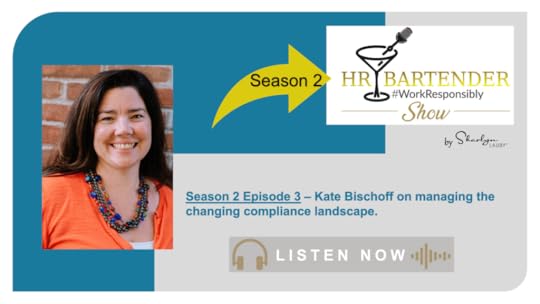
Estimated reading time: 3 minutes
Compliance is a big part of our role as human resources professionals. That being said, it doesn’t have to be our only role. And compliance is more than writing a bunch of policies.
In fact, today’s compliance landscape involves knowing when to write a policy. It also means knowing when to advocate for legislative change and when to push for organizational change (because of employee reaction to a legislative change).
I am so thrilled to speak with Kate Bischoff in this episode. Kate is a HR pro and employment law attorney. She consults with organizations to find solutions that meet business needs and the law’s requirements. Prior to starting her own business, Kate served as the HR Officer for Consulate General of the United States, Jerusalem, and the U.S. Embassy Lusaka, Zambia. She has been recognized by The New York Times, CNN, the Wall Street Journal, USA TODAY, NPR, and other journalistic sources as a leading authority on harassment, technology in the workplace, and employment law.
I am also grateful that Kate is always willing to help us with reader questions like the time an HR representative posted a racist comment.

When it comes to HR and compliance, there’s a technical piece and a human piece. Organizations might be able to save a few dollars when it comes to compliance but the “cost of being perceived” as being non-compliant is huge. It’s also very difficult to recover from. Doing the right thing is not only good for the organization, it’s good for everyone in the organization. That means being prepared to deal with compliance and change.
Connect with Kate Bischoff
Twitter: @k8bisch (https://twitter.com/k8bisch)
LinkedIn: https://www.linkedin.com/in/k8bisch/
Website: https://k8bisch.com
Be sure to check out Kate’s video series on the employee handbook.
Season 2 Episode 3 – Kate Bischoff Show Notes
Season 2 Episode 3 – Kate Bischoff Transcripts
Thanks for listening to our podcast. This season of the HR Bartender show is brought to you by our friends at Ultimate Kronos Group (UKG), a leading global provider of human capital management, payroll, HR service delivery, and workforce management solutions.
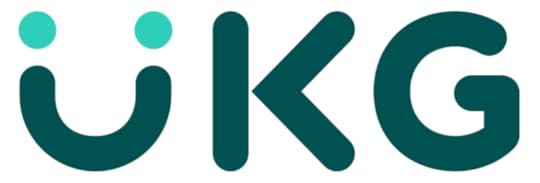
You can subscribe to the HR Bartender show on Apple Podcasts, Spotify, Google Podcasts, Stitcher, and TuneIn. And we would absolutely love it if you would leave a review.
If you enjoyed this episode, be sure to check out other episodes on our podcast page.
The post Change Management [Season 2 Episode 3] Societal Issues are Becoming HR Compliance Matters appeared first on hr bartender.
November 13, 2022
Salary Disclosure Laws Can Help Create Pay Equity
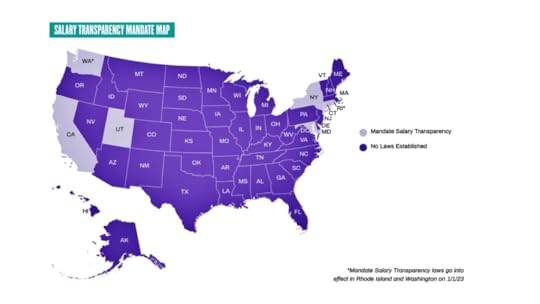
Estimated reading time: 8 minutes
You’ve probably been reading a lot of information lately about salary disclosure laws. As of today, five states (CA, CO, CT, MD, and NY) require employers to share pay ranges and two (RI, WA) will be starting in January 2023. This is a trend that organizations should pay attention to and learn more about.
Monster recently conducted a poll about salary disclosures with some very interesting results. Nearly all workers (98%) believe employers should disclose salary ranges in their job postings, and more than half (53%) would refuse to apply for a job that does not disclose the salary range. To learn more, I reached out to Vicki Salemi, Monster’s career expert. Monster has created a Salary Disclosure Hub to help organizations and individuals learn more about salary disclosure laws and their impact.
I know I don’t have to say this but as a reminder, the world of employment law can move pretty quickly at times. Please remember that Vicki’s comments shouldn’t be construed as legal advice or as pertaining to any specific factual situations. If you have detailed questions, they should be addressed directly with your friendly neighborhood labor and employment attorney.
Vicki, thanks so much for being here. There’s been a lot of conversation about “salary disclosure” laws. In a few sentences, what is a salary disclosure law?
[Salemi] Overall, salary disclosure laws require employers to share ranges of the job’s salary within the job description advertisement; essentially, pay transparency. It may vary by state with minor tweaks. For instance, in New York City it pertains to employers with four or more employees, or one or more domestic workers as long as one of the employees works in NYC.
How do salary disclosure laws align with “salary history bans” where employers cannot ask a candidate for their salary history?

[Salemi] They’re under the umbrella of pay equity. Salary history bans prohibit employers, in many states, from asking a candidate for their salary history. When I worked in corporate recruiting, there were often two sets of questions to ask up front: salary expectations and current/former salary. Now, salary history bans help employers and candidates focus on the first set – someone’s salary expectations.
Salary disclosure laws can help job seekers set their expectations for the job they’re pursuing by having access to the range. They also help shape the framework of job seekers who know their worth and know what the job pays before they apply. Additionally, it helps current employees see their company’s job postings to check if their current pay is on par with what the company plans to pay new hires.
Many workers are optimistic about how salary disclosure laws may positively impact the future of work. According to a recent Monster poll, 53% believe it will lead to salary equity and smaller or no pay gaps and 43% think it will result in overall higher wages for all workers.
What are the advantages and disadvantages for employers subject to salary disclosures?
[Salemi] There are several advantages to employers. For starters, it’s a step in the right direction for pay equity – they’re part of the solution. In addition, they’re remaining competitive with other employers who are all vying for the same talent.
This also helps eliminate salary conversations that are usually involved while screening candidates. As a corporate recruiter, I was the initial gatekeeper to scheduling a first interview with the hiring team. Salary always had to be addressed during the phone screen to see if we were on the same page to be cognizant and respectful of everyone’s time and energy.
This is a total game changer and addresses salary up front, thereby saving time for the employer. They can go into that phone screen with the assumption that candidates are on the same page since the salary range was disclosed.
One disadvantage, and I say this facetiously, is that employers who don’t abide should anticipate being held accountable. If an employer violates salary disclosure laws, from Monster poll data, more than three out of four (77%) workers would consider reporting them to the authorities. Aside from that, it’s less than likely they’ll apply to the job, and it could be harder for the company to attract and hire candidates.
Another disadvantage, which only applies to employers who aren’t above board, is they may be underpaying their employees and resent the fact that salary ranges are easily accessible, especially when it’s a job posting for the same or similar job.
Again, salary disclosure is a step towards pay equity — these facetious disadvantages don’t apply to employers who are above board with abiding by the disclosure law and paying current workers fairly. This holds employers accountable.
That said, one in five workers (22% per Monster data) are concerned that salary disclosure can create tension between colleagues due to unequal pay; 18% believe it will bring more pay discrimination lawsuits against employers.
And what are the advantages / disadvantages for candidates applying for jobs where salary disclosure exists?
[Salemi] Advantages for candidates include knowing the range the job pays in states where salary disclosure exists. Another pro is they can advocate for themselves internally. According to Monster data, almost half of workers (40%) would use salary disclosure as leverage to get a raise at their current job if they saw a posting for their role or similar one from their employer with higher pay.
Disadvantages: the range may be broad — that’s why it’s important for the job seeker to do external research (i.e., contact former bosses, colleagues, industry association organizations, etc.) to find out where their salary should fall within the range.
This isn’t so much of a disadvantage, but more of a yellow caution light: don’t only look at salary as the only criteria for whether to pursue a job. While 61% of respondents in the Monster poll said salary is their top consideration in looking for a new job, a significant number, 39%, said they also factor work-life balance, benefits, and perks first.
So, the salary range is certainly useful information for job seekers, but it’s not the only information to rely on when deciding whether to pursue a job to determine if it’s the overall right fit.
One of the things I’m starting to read about are organizations posting a ridiculously wide salary range – like $0 to $2M. I can’t help but think this makes the employer look petty. What advice do you have for organizations thinking these wide salary ranges are a good strategy?
[Salemi] It’s a good strategy for employers to be as realistic as possible with a range that is feasible. Posting a wide salary range is counterintuitive to this law.
Job seekers are savvy. They’ll see right through it. If a company isn’t truthful about a salary range, it can cause the job seeker to skip right over it. They may wonder what else is broad and vague in the job description, not even bother to evaluate it, and immediately move onto another job posting from an employer who’s transparent and realistic. It’s in an employer’s best interest, especially in this tight labor market, to do the best they can to be accurate with the range.
As with anything new, as this rolls out there will likely be hiccups here and there and it is normal for some ranges to be broad or overlap (for instance, a senior associate may be $65K to $90K whereas the next level, a manager, may be $80K to $100K), but if organizations think extremely wide salary ranges are a good strategy like $0 to $2M, they should think again.
How are job boards, like Monster.com , informing employers that they must post salary ranges?
[Salemi] We’ve communicated with our customers about the new salary transparency laws and require that employers comply with all laws.
Last question. We discussed earlier the advantages and disadvantages to salary disclosures. If I’m operating in a state without disclosure laws, could it be a competitive advantage to post them anyway?
[Salemi] Yes, it’s definitely a competitive advantage for employers to post salaries anyway even if they operate in a state without specific disclosure laws.
There are a few reasons: Job seekers may become accustomed to seeing salaries disclosed on job postings. As you mentioned earlier, an overwhelming majority (98%) believe employers should disclose salary ranges in their job postings and more than half (53%) would refuse to apply for a job that doesn’t disclose the range!
For example, if a job seeker lives in Hoboken, New Jersey and they’re looking for jobs in NYC, they’ll see salary range after salary range for jobs in Manhattan. It’s a valuable discerning piece of information for the jobs they’re applying to. Then, the same job seeker may toggle to jobs in NJ and not see any salary ranges since it’s not required by law. It’s in a company’s best interest to stay competitive. In the spirit of transparency in this example, it may be beneficial for NJ employers to post salary ranges anyway even if they’re not required to do so by law. That job seeker may promptly skip right over jobs, even ones that may be a fit, because they don’t have salary information.
This transcends beyond location as well with so many job seekers looking for hybrid or remote work. A job seeker looking for remote work in a state that doesn’t require salary transparency may not be able to make an adequate conclusion about whether to apply for a job posting that does not disclose salary and simply skip over it.
A huge thanks to Vicki for sharing this information with us. I hope you’ll take a moment to check out Monster’s Salary Disclosure Hub for additional information and updates.
My two cents: no one wants to waste time during the hiring process. Candidates don’t want to interview 2, 3, or more times only to find out their job requirements aren’t in the range. Organizations don’t want to do it either. Having conversations upfront about pay only make sense. In fact, why not just post the range so that people know this information before they apply. That way the hiring process is focused on the candidate and company getting to know each other.
The post Salary Disclosure Laws Can Help Create Pay Equity appeared first on hr bartender.
November 10, 2022
Withholding Expense Reimbursements – Ask #HR Bartender

Estimated reading time: 3 minutes
No, messing with a someone’s money isn’t cool. Organizations don’t like it when customers or vendors don’t pay on time. So, it shouldn’t be a surprise that employees don’t like it when they feel the company is messing with their money. That’s what today’s reader note is all about.
Can a company withhold money due to you, when you have traveled for business purposes using your own vehicle?
There are so many things we don’t know about this situation. For example, where are the company and employee located? What is the employee’s position? Was there an agreement or understanding in place about business travel reimbursements? How much money are we talking about? And there are more questions that could pop up as we start to investigate.
I’ve published some articles about expense reimbursements in the past, so I’m hoping these might provide some place to start. It probably won’t answer every detail, but maybe it will help someone ask the right questions to get resolution.
Should Employees Receive an Auto Allowance
Asking an employee to run a quick errand or drop off something at another location might not seem like a big deal at the time. And employees might be very willing to do it. But it can quickly become a gripe if it’s abused OR if it’s not compensated properly. Organizations need to do their homework and make sure employees are being paid for the work they do and reimbursed for the expenses they incur.
Company Refuses to Reimburse Expenses
Whether it’s an employee’s paycheck or their expense report, the conversation is about money, and no one enjoys having their money withheld from them. Organizations need to clearly communicate expense reimbursement and allowances, so employees do not have their purchases denied. No one wins in these situations.
Asking Employees for Reimbursement After They’ve Departed
Rules, policies, and procedures can be a real challenge at times. Especially when the rule is completely unnecessary. But there are times when rules serve a valuable purpose. They allow us to handle situations consistently.
Employer Sends Invoice to Former Employee
Overpaying employees is a serious issue. This might not be a regular occurrence at your organization. But knowing that there are legal aspects to consider will hopefully put you in a place to get the information needed to make a good decision.
I wish there was a clear single answer when it comes to situations like this. Unfortunately, there are several dynamics to consider. Hopefully, the employee has a place to express their concerns (i.e., Human Resources) and the matter can be investigated.
Image captured by Sharlyn Lauby while exploring the streets of Salt Lake City, UT
The post Withholding Expense Reimbursements – Ask #HR Bartender appeared first on hr bartender.
November 8, 2022
Empower Your People and Business: UKG FREE HR and Payroll eSymposium

(Editor’s Note: Today’s article is brought to you by our friends at Ultimate Kronos Group (UKG ) . Each month, UKG shares a workforce activity report which takes a deeper diver into labor index data. Check it out the latest report . Enjoy the article!)
As we’re approaching year end, one of the things I’m looking for are professional development events that are focused on future business trends. I want to hear from quality speakers who will challenge me and get me ready for the new year. And it’s a huge bonus when the event is FREE – especially with current travel costs!
If you’re doing the same thing, then this is your reminder that the UKG HR & Payroll eSymposium is coming up on Wednesday, December 7, 2022, from 10a to 4p Eastern. The theme is “Choose Purpose: Empower Your People & Business” which I think is a very timely topic. Organizations are very focused on performance and results right now. HR and payroll are key to a high-performing organization. Here’s some more information about this virtual program:
Choose Purpose: Empower Your People & BusinessThe eSymposium is divided into four tracks: find your purpose, deliver purposeful payroll, craft a purpose-driven culture, and connect people to purpose. You can check out the entire agenda and speaker profiles by visiting the UKG website, but I did want to share a few of the sessions.
Overcome Overthinking: Making Decisions to Get Things Done – Analysis paralysis, or the all-too-familiar act of overthinking, is not uncommon in life or business. Are there processes that you know you need to change, but you just haven’t done it? This session will explore ways to become unstuck — by knowing the signs and symptoms of analysis paralysis and following the concept of the four “Ts” to propel you forward! (Side note: I spoke to Julie Develin, SHRM-SCP in an episode of The HR Bartender Show last season so I know this will be a great session.)
Financial Wellness in The New Era of Payroll – On the surface, payroll doesn’t look like one of the areas of the business that needs major changes. But the reality is, much has changed over the last several years when it comes to the role payroll plays in an organization. Today’s payroll professionals are expected to help employees feel more supported, engaged, motivated, and financially confident at work and at home through a more people-centric payroll approach.
Finding a Cure for Quiet Quitting – You’ve likely heard of “quiet quitting,” where employees actively decide to not go above and beyond in their roles. It’s taking the working world by storm and it’s probably happening at your organization right now. While employees decide to quietly quit for a variety of reasons, what if you could prevent quiet quitting from happening in the first place? Dr. Chris Mullen,SHRM-SCP, executive director of The Workforce Institute at UKG, is joined by a panel of culture experts to discuss how to inspire your people at work.
An Inside Look Supporting and Leading Employee Resource Groups (ERG) – Employee Resource Groups (ERGs) are a strategy that organizations use to better engage, support, and retain their employees while also strengthening their diversity, equity, inclusion, and belonging (DEIB) initiatives. Join this session to hear from DEIB and ERG leaders on best practices for creating an ERG framework, how organizations can set ERG leaders up for success, and how ERG leaders can set themselves up for success.

I know we’re focused on a lot of things right now. And I’m sure there are days when we say to ourselves that we can’t possibly think about taking time off to attend a professional development program. But we must find the time. We need to take some of our own advice. If a manager or employee came to us about not having time for learning, we’d tell them that “developing our knowledge and skills makes us better at our jobs”. And it’s true.
UKG eSymposium: 4 Reasons You Should AttendI’ve been participating in the UKG eSymposiums for a few years and find them to consistently be a high-quality learning opportunity. Here are four benefits of attending this event.
The content is relevant and high-quality. One of the things that I really like about this event is that it brings together HR and payroll. I’ve been responsible for both a few times in my career, and this is one of the few events that has topics which are relevant to both. Since the event is free, your organization can have multiple people attend, and then maybe set up a meeting to discuss the sessions. It’s a great way for HR and payroll to learn from each other.The sessions will be recorded. If you’re not able to attend the live sessions, no worries. Most sessions will be made available on demand. That way if you’re torn between two sessions then you can listen to one live and the other on demand. Or if you do have to step away, you can still listen to the recording and not miss out on the information. I must admit there are times when I prefer listening to the recordings. It allows me to schedule my learning over time. It’s approved for recertification credits. The sessions have been pre-approved by the Society for Human Resource Management (SHRM) and the Human Resources Certification Institute (HRCI). In addition, many have been approved by the American Payroll Association (APA). And for my Canadian friends , this event is also pre-approved by the Human Resources Professionals Association (HRPA), Chartered Professionals in Human Resources Saskatchewan (CPHR-SK) and the National Payroll Institute (NPI). UKG will be providing a certificate of participation for your files. Recertification credits are important, especially if budgets are tight.It’s FREE. Speaking of watching budgets, when we can find a good, free event, we need to take advantage of them. Because let’s face it, sometimes free things are good and sometimes … well, they’re not. And as much as we might want to travel to an event right now, the cost of travel is pricey. This is one of those good, free events.HR and Payroll: Time to Focus on Our Professional DevelopmentThe UKG eSymposium for HR and payroll professionals is designed to deliver education on the topics we face every day and could potentially face in the future. It has, what I believe, are the benefits many of us look for in professional development opportunities:
1) high-quality content,
2) no cost to attend, and
3) pre-approved for recertification.
We all know this doesn’t happen very often. Find some time to focus on your professional development. It’s important. Sign up for the UKG eSymposium. Here are the registration details:
Choose Purpose: Empower Your People & Business
Wednesday, December 7, 2022, 10a to 4p Eastern
Look forward to seeing you there!
The post Empower Your People and Business: UKG FREE HR and Payroll eSymposium appeared first on hr bartender.
November 6, 2022
Change Management [Season 2 Episode 2] The Role of HR in Managing Organizational Change
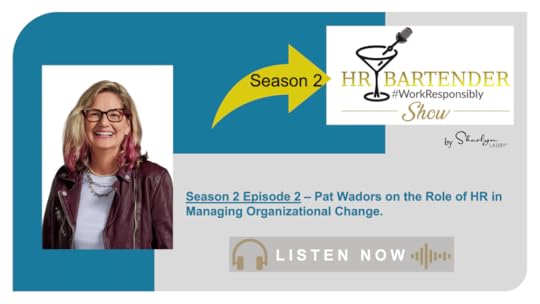
Estimated reading time: 3 minutes
HR professionals are often referred to as change agents. So, how does Human Resources help the organization through a change effort? Well, sometimes it’s about leading through effective communication.
In this episode, I chat with Pat Wadors, UKG’s chief people officer (CPO). Pat oversees the critical Human Resources functions that bring the employee experience to life, including talent acquisition and development, compensation and benefits, employee listening and people analytics, employee communications, HR technology, HR business consultants and shared services, and components of workplaces services and physical security. Her personal mission is to ensure that U Krewers around the world are better people for having worked at UKG.
Pat believes that organizations thrive when they have a blend of people with differing backgrounds and ways of thinking, and who feel they belong as a contributor to the company’s success. As a multiple recipient of the National Diversity Council’s Top 50 Most Powerful Women in Technology, Pat is a frequent speaker on HCM, diversity, and inclusion issues, and has served on the board of several prominent technology companies. Prior to UKG, Pat served as CPO of Procore Technologies, and has held multiple leadership roles at ServiceNow, LinkedIn, Plantronics, Inc., and Yahoo!

Organizations run the risk of losing their competitive advantage to change if they get too big, too siloed, or too busy to communicate. One of the ways HR professionals can take the lead in an organizational change effort is by building relationships with the management team. By showing empathy and being there to talk through challenges, HR professionals can give managers the tools to process change. Even the unpleasant changes that we can’t always control.
Connect with Pat Wadors
Twitter: @wadors (https://twitter.com/wadors)
LinkedIn: https://www.linkedin.com/in/patwadors/
During our conversation, Pat mentioned the phrase “touching the elephant”, which is from an old parable about blind men touching an elephant. She also cited Brene Brown and “honest rumbles”. And lastly, we mentioned servant leadership and consensus building, so I wanted to share a couple of articles in those areas.
Since this episode had a focus on frontline managers, if you’re interested in learning more about frontline manager training, check out this UKG white paper “Training Frontline Managers: 5 Critical Skills for Success”.
Season 2 Episode 2 – Pat Wadors Show Notes
Season 2 Episode 2 – Pat Wadors Transcript
Thanks for listening to our podcast. This season of the HR Bartender show is brought to you by our friends at Ultimate Kronos Group (UKG), a leading global provider of human capital management, payroll, HR service delivery, and workforce management solutions.

You can subscribe to the HR Bartender show on Apple Podcasts, Spotify, Google Podcasts, Stitcher, and TuneIn. And we would absolutely love it if you would leave a review.
If you enjoyed this episode, be sure to check out other episodes on our podcast page.
The post Change Management [Season 2 Episode 2] The Role of HR in Managing Organizational Change appeared first on hr bartender.
November 3, 2022
Always Conduct a Post Hire Debrief
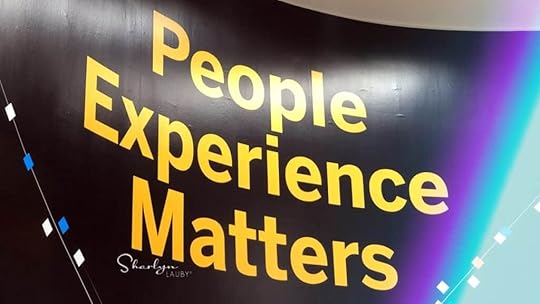
Estimated reading time: 3 minutes
I’m a big fan of the recruiting strategy meeting, sometimes called the manager intake meeting. This is the conversation between the recruiter and the hiring manager about the open job. I think there are a lot of things to discuss, including:
Review the job descriptionDiscuss must-have knowledge, skills, and abilitiesA typical day in the life for this positionTeam dynamicsSourcing strategiesInterview processAnd expectations for the new hire in their first 30/60/90 daysEven when we regularly recruit for the same position, it’s important to still have these conversations. I’ve been caught a few times because the hiring manager and I were both too busy, so we skipped the meeting. Later, we realized that we missed discussing a change to the job or the budget. It impacted our hiring process – and not in a good way.
So having that pre-meeting is important. What’s equally important is to have a post-hire debrief. This is not only a time to find out how the new hire is doing, but to discuss how the process worked. I like keeping things simple, so here’s a two-question debrief:
What did we do well? I always like asking this question first because sometimes we want to immediately go to all the things that went wrong. There were things that went well and it’s important to acknowledge them. A hiring manager might share that they asked a question that they hadn’t asked before and was impressed with the response. Or they might mention that we discussed something during the recruiting strategy meeting that was helpful during the process. What could we do differently next time? This isn’t a what did we do wrong question because maybe we didn’t do anything wrong. But it’s possible there are some things that we’d like to change. Hiring managers might discuss using different sources or adding a panel interview format instead of individual interviews. We could spend some time talking about how much time the process took and are there places we can be more efficient.When should you conduct the post-hire debrief? Well, that’s a conversation for the recruiter and hiring manager. Many organizations conduct 90-day / introductory performance reviews so it could make sense to do it before then. But wait long enough for the hiring manager to have some specifics to share about the employee’s performance, maybe a minimum of 30-45 days post-hire.
Recruiters and hiring managers are a team and all good teams do regular debriefs to get better. Several years ago, I interviewed Dr. Scott Tannenbaum about group debriefs. I remember him saying teams that conduct regular debriefs perform an average of 20% better. While I’ll admit the research is a bit dated, there’s also some logic attached to it that I’d like to believe holds up over time. Teams that take the time to debrief are communicating and sharing at a higher level, which should translate into better processes. Which by the way, should translate into better hires.
Recruiting teams that take the time to conduct a recruiting strategy meeting are planning well. And then, if they conduct the debrief, they are setting themselves up for success the next time. This (hopefully!) results in greater applicant flow, a better candidate experience, and ultimately a great new hire.
Image captured by Sharlyn Lauby while exploring the streets of London, England
The post Always Conduct a Post Hire Debrief appeared first on hr bartender.
November 1, 2022
Change Management [Season 2 Episode 1]: How HR Can Manage Change
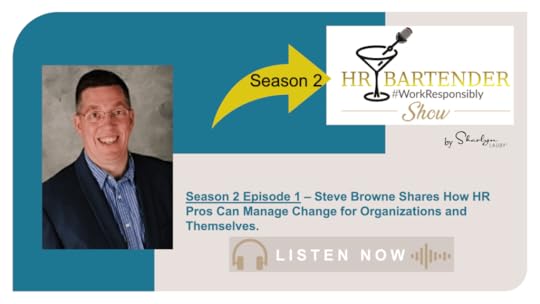
Estimated reading time: 3 minutes
The Greek philosopher Heraclitus said, “Change is the only constant in life.” and it’s so true. Whether personally or professionally, we’ve been dealing with a lot of change over the past few years. So, I thought it appropriate to focus this season of The HR Bartender Show on change management.
HR professionals need to be able to not only help the organization manage change but be able to individually process change at the same time. That’s how HR brings value to the organization.
I’m really delighted to start Season 2 with my friend Steve Browne. Many of you know Steve because of his nationally recognized HR blog called Everyday People and presence on social media. His “day job” is chief people officer at LaRosa’s, Inc., a regional pizzeria restaurant chain in Southwest Ohio with 10 locations and more than 1,100 team members.
Steve often ranks among the most influential voices in human resources. He is the author of two best-selling books, “HR on Purpose!! Developing Deliberate People Passion” and “HR Rising!! From Ownership to Leadership”.

HR professionals must allocate their time to work on the right things. Having a proven change model to rely on can help with the process. The good news is there are many such models available. Choose the one that works best for you. It should include the actual planning phase, implementation strategies, equipping employees with the right tools, and regular communication.
Connect with Steve Browne
Steve’s blog, Everyday People: https://www.sbrownehr.com
LinkedIn: https://www.linkedin.com/in/steveb5/
Twitter: https://twitter.com/sbrownehr
During the show, I mentioned that this isn’t Steve’s first visit to HR Bartender. Steve and I chatted a few years ago on this article about “How to Get Your First Job in Human Resources”. I hope you’ll check it out.
I mentioned a change management conversation about “pencils, pens, and sharpies”. And Steve mentioned the SHRM Executive Network.
Season 2 Episode 1 – Steve Browne Show Notes
Season 2 Episode 1 – Steve Browne Transcript
Thanks for listening to our podcast. This season of the HR Bartender show is brought to you by our friends at Ultimate Kronos Group (UKG), a leading global provider of human capital management, payroll, HR service delivery, and workforce management solutions.

You can subscribe to the HR Bartender show on Apple Podcasts, Spotify, Google Podcasts, Stitcher, and TuneIn. And we would absolutely love it if you would leave a review.
If you enjoyed this episode, be sure to check out other episodes on our podcast page.
The post Change Management [Season 2 Episode 1]: How HR Can Manage Change appeared first on hr bartender.
October 30, 2022
Talent Hoarding and Employee Retention are Two Different Things
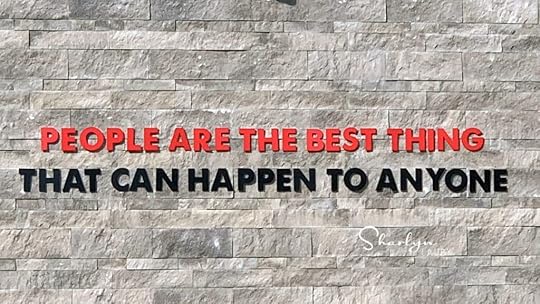
Estimated reading time: 3 minutes
We know what employee retention is, right?! It’s the organization’s ability to keep employees. The way we do that is by having a work environment that people want to be a part of. One where employees feel they are valued and supported.
There’s another term being discussed right now when it comes to keeping employees. It’s called talent hoarding. This is when organizations prevent employees from pursuing their career goals because they want to keep them right where they are. Sometimes when managers find a high potential or high performing employee, they might hoard them from the rest of the organization.
I’m sure we can all empathize with the delight a manager feels when they find an absolutely fantastic employee. But if the thought has crossed your mind to keep that employee a secret from the rest of the company, let me assure you that talent hoarding is not the answer. In fact, talent hoarding could have the opposite effect – a disengaged and disgruntled employee who eventually leaves the company.
Employees want to know that the organization they work for supports their career. In a 2021 Gallup study, 61% of employees said they will stay at companies that invest in their training and development. This aligns with a LinkedIn study that said 94% of employees would stay at a company that invests in their growth.
I’ve said before that a manager’s primary role is to find and train their replacement. This isn’t something that happens overnight. It takes time. Managers should be spending time thinking about developing employees who they can delegate to. Otherwise, it becomes a challenge for the manager to work on a special project or attend training because their department falls apart when they’re gone. So, when managers hoard employees, they’re actually hurting both their career goals and the employees’.
But let’s say that despite the manager’s department occasionally falling into chaos, the manager gets a promotion. Since that manager didn’t spend any time developing their employees, there’s no one to promote into the manager’s role. We all know what this means. The manager must do their old job PLUS their new job until a replacement is found. (Oh, and P.S. I know I don’t have to say it, but I will. The manager isn’t going to get more money for the extra workload.) During a period in time when the manager should be focused on their new job and being set up for success, they’re being pulled in multiple directions. Not a good situation for the manager or the company.
The reason I’m bringing this up is because it could be very tempting right now for managers to want to show the organization that they’re indispensable. And they may falsely believe the way to do that is by talent hoarding. Nothing could be further from the truth. Truly indispensable managers are the ones who encourage employee growth.
Organizations that focus on employee learning and development will benefit with a more skilled workforce and better employee retention. This translates into increased productivity and excellent customer service, which ultimately will reflect on the bottom line.
Image captured by Sharlyn Lauby while exploring the streets of Gainesville, FL
The post Talent Hoarding and Employee Retention are Two Different Things appeared first on hr bartender.
October 27, 2022
Bookmark This! The Final Paychecks Edition – HR Bartender
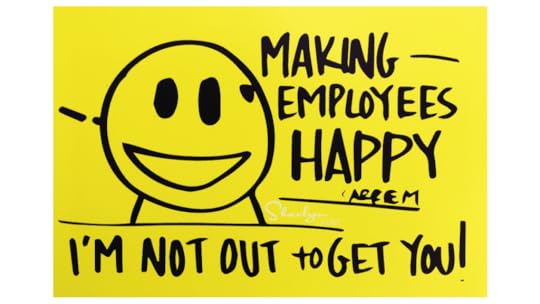
Estimated reading time: 3 minutes
Today’s reader question is a tough one. It involves final paychecks.
I am in medical sales as a product specialist. I live/work in California for a company that is based out of Minnesota. I provided my resignation letter on September 9 with my last day noted as September 15.
The company states that ‘employees will not be paid for any accrued or unused PTO after leaving the company for any reason unless otherwise required by state law’. Additionally, they do not have the accrued hours available on any paystubs or online tools. The HR department would not provide me with my current hours since ‘they will not be paid out’. They also stated I will need to wait until the next salary pay period – 8 days (including weekend days) after my last day, and 22 days for my commission to be paid out. Lastly, my remaining expense reports will not be paid out until after they receive my laptop and work cell phone.
While this seems to follow Minnesota labor laws, am I fully protected under California labor laws as my entire territory is within CA and I live/have always resided in CA during my time with this company? Again, this is not a remote job.
Final paychecks are a tricky subject because each state has their own laws regarding when final checks should be issued. And there are things we don’t know about this situation like company policies and what agreements were made between the company and the employee. So, it’s difficult to answer with certainty.
But this reader note is a good reminder that organizations need to understand the laws of both where they operate and where employees live/work. With the increase in remote and hybrid work, organizations should not make assumptions about state laws.
Final Paychecks: Do’s and Don’ts – It’s important to know what is permissible when it comes to your final paycheck. If you’re ever in doubt, seek advice. It is possible to get educated about a subject without filing a lawsuit.
Final Paycheck Has Too Many Deductions – When an employee is leaving the organization, they need information about their final paycheck. When to expect it and how it will be calculated. Regardless of how the employee leaves. The organization should take a moment to share the information.
Employment Laws: Where Employees Work or Live – there are no one-size-fits-all solutions when it comes to employment issues. We must keep in mind federal, state, and in some cases local laws. While we don’t need to memorize all the laws, we do need to have partners that can provide us with answers.
Employees: When Should You Lawyer Up – No one wants to escalate issues to lawyers and government agencies, but unfortunately, sometimes it must be done. The answer isn’t seeking free legal advice. It’s getting educated on the right times to use these options.
Whether you’re an individual or an organization, it’s important to understand what and when international, federal, state, and local labor laws apply. The concept of a workplace is becoming very flexible so knowing this information at the beginning will avoid misunderstandings later.
Image captured by Sharlyn Lauby at the HR Technology Conference in Las Vegas, NV
The post Bookmark This! The Final Paychecks Edition – HR Bartender appeared first on hr bartender.
October 25, 2022
7 Questions That Will Make Your Recruiting Process More Efficient

Estimated reading time: 6 minutes
(Editor’s Note: Today’s article is brought to you by our friends at Accurate Background , a leading provider of compliant background checks, drug and health screenings, and Form I-9 verifications. They’ve been named to Inc. Magazine’s list of the fastest-growing private companies for the eighth time . Congrats to them. Enjoy the read!)
It always makes sense to regularly review current processes and see if there are places to make them more efficient. I believe recruiting is one of those processes. Regardless of what’s happening in the labor market, no one wants to waste time or resources during the hiring process.
So, I thought it might be helpful to put together a list of questions that recruiting teams might want to ask themselves. The idea behind this list is to not assume anything about what’s currently being done. So, don’t just immediately reply with “Oh yeah, we do that.”
Organizations change. That’s not a bad thing. In fact, it could be a very good thing. But it does mean that we need to make sure that our organizational processes remained aligned.
7 Recruiting Questions to Make Your Process More EfficientI think the best way to use this list is to bring a group of key stakeholders together to discuss the answers. Approach these questions like you’re totally new to the organization, don’t have any history, and just simply want to know what’s going on.
What recruiting metrics matter to us? Organizations don’t have to calculate everything, but what they do measure needs to matter. As we’re spending less time talking about the pandemic, organizations are making decisions about how they will manage the operation. Now might be the right time to also reevaluate what recruiting metrics they measure and make some adjustments. Have managers bought into the candidate experience? I’m not implying here that managers don’t care about candidates. However, there have been countless articles written about how employee expectations have changed over the past few years, so it’s only logical that the candidate experience might have changed as well. Review the current candidate experience. Make sure it aligns with what the organization wants it to be. And most importantly, that everyone knows it. Do we conduct recruiting strategy meetings for all open jobs? A recruiting strategy meeting (some might call it a manager intake meeting) is the opportunity for the recruiter and the hiring manager to discuss the job and the process for finding the best candidate. It’s necessary to have this meeting, even for positions that you recruit on a regular basis. Small changes can happen to the job requirements which add up to big changes over time. This can create a disconnect when it comes to sourcing and screening. Are resources available to test new sources? The last thing that any recruiter wants is for their “go to” source to stop delivering results. But it happens. And when it does, recruiters need to be ready with a Plan B. Years ago, I heard a panel of recruiters talk about testing sources, so they didn’t rely on a small number of sources. But this takes organizational support in terms of time and budget dollars. It also means developing a list of criteria for what a good source can deliver. Has the organization embraced the latest recruiting technologies? Today’s recruiting technologies can help to reduce administration time and deliver a better experience – for candidates, hiring managers, and HR. In fact, it could make some sense to ask this question in the context of all three stakeholders. For example, a process that’s great for HR but not great for hiring managers and candidates, isn’t necessarily delivering an efficient experience. Are we using selection tools to make good decisions? When I refer to selection tools, I’m talking about assessments and background checks. Assessments can help organizations confirm skills. Please remember that a pre-employment assessment should be valid, reliable, and aligned with the process of selection. Background checks provide a comprehensive search of a candidate’s information. Common background checks include credit, criminal, driving, Form I-9, health, and drug screening. One additional screening that organizations might want to dedicate some time to consider is social media background checks. (And I don’t mean just Googling the candidate.) Do we have a plan in place to create a smooth transition from candidate to employee? The recruiting process doesn’t end with the job offer. It’s essential to make sure the candidate has a smooth transition to employee. This could include preboarding, buddy programs, etc. The reason that organizations should consider this a part of the hiring process is because if an employee leaves in the first six months…well, that’s not an efficient recruiting process. Granted, the reason the employee left might not have anything to do with the recruiting process. But the recruiting process will be overloaded if employees don’t stay.Oh, and here’s a BONUS question for recruiting professionals to ask themselves: Am I spending time learning new recruiting strategies? Just because we’ve been recruiting for years, doesn’t mean we can stop learning. We need to read, listen to new voices, and take educational offerings to help us stay on top of our profession.

Speaking of learning, I’m partnering with the Accurate Background team on a webinar discussing “Better Candidate Selection is the Key to Employee Retention”. The webinar is Wednesday, November 9, 2022, at 2p Eastern. I hope you can join us. I think selection is such an important part of the overall recruitment process and one we don’t talk about nearly enough. And as always, if you’re already booked, please sign up to get the recording. The program is pre-approved for SHRM and HRCI recertification credits.
Candidates and Employees Want to Work at Efficient CompaniesI made the comment earlier in this article that when we hire someone and they leave shortly after starting, that puts a strain on the recruiting function. It’s one of the reasons we need to regularly ask these questions about the efficiency of our processes. Because if we have a good process, then hopefully candidates see that and want to be a part of an efficient and successful organization.
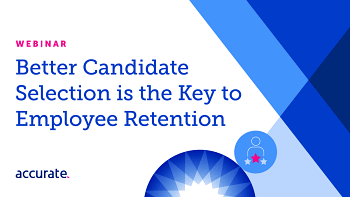
The post 7 Questions That Will Make Your Recruiting Process More Efficient appeared first on hr bartender.
Sharlyn J. Lauby's Blog
- Sharlyn J. Lauby's profile
- 10 followers



